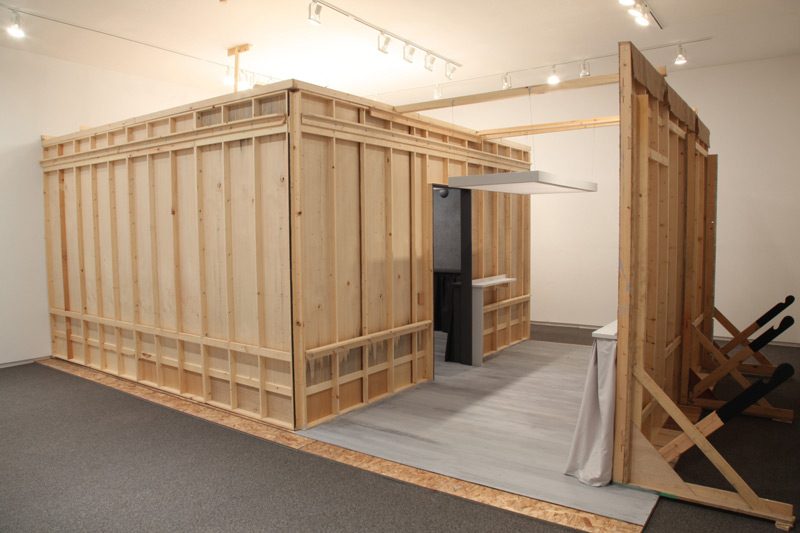Presentation House Gallery, North Vancouver
13 September to 2 November 2014
By Karen Henry
The title of Kelly Lycan’s show, Underglow, incorporates her interest in consumer culture, photography, high art, and cultures of display. Lycan uses the connotations of luminous detailing in car culture, cosmetic techniques that add shimmering radiance, and, in general, the use of light to emphasize form to animate the role of light in photography. The exhibition is, on the surface, the most austere of several recent Vancouver-area shows in which Lycan sets up associations among assembled objects, spaces, and the production of images. However, once a viewer begins to interact with the exhibition, it is a surprisingly embodied and sensual experience.
There are three installations in the show, although the one in the central area of the gallery is not obvious. In this “in between” space, the installation called Approximations, PHG 1985–2005 consists of a number of banal interventions that mimic photographs of installations from the gallery’s history, including an arrangement of chairs set up to face the vacant corner, as if in preparation for a talk. The black baseboards, wall plugs, and dummy lights are embellishments marking an earlier time at the gallery. Unless you realize that this is an artwork, you might assume that it is a space for socializing and education. Doorways are also outlined with narrow strips of mirror, picking up abstract swaths of light and movement and creating disjunctures in the space.
291, From the Faraway Nearby is a sculptural tableau: a full-scale replica of the art gallery 291 as seen in a 1906 photograph by Alfred Stieglitz. The renowned gallery in New York City was largely credited with bringing photography into the fold of modern art. It hosted early shows of pictorialist photography as well as some of the first exhibitions of European modernists, including Matisse, Cezanne, and Duchamp. Stieglitz was the visionary behind this movement and the gallery, along with Edward Steichen. His European roots provided a cultural bridge between the artists from two continents, and the gallery produced over eighty exhibitions between 1905 and 1917, when the war intervened and Stieglitz began his relationship with Georgia O’Keefe. From the Faraway Nearby is also the title of a 1938 painting by O’Keefe, depicting a spectacular rack of antlers over a distant desert landscape. “Faraway nearby” evokes the nature of the relationship between Stieglitz and O’Keefe: they lived apart much of the time, in different parts of the United States, and they had other relationships, but they wrote extensive letters to each other throughout their thirty-year affair. Lycan’s work thus also speaks to the conflation of space and time in a photograph.
As we viewers move toward the installation, the space appears flattened, providing a convincing illusion of entering a black-and-white photogravure. It is a little disorienting, because it is not “life-like.” The muted light, the grey walls and floor, and the dark dried leaves are slightly ominous. The impression is of a space from another time held in stasis – the small scale, the burlap wall texture, the hanging domed lamps, the funereal vase and somber draperies, and, of course, the empty walls. Once we are inside, the contrivance becomes more immediate as we explore the details by the light of the skylight illuminated by humming fluorescent bulbs. Through the second doorway, the wall looks strangely foreshortened; as we step through, the built structure is revealed, like a theatre set. Ironically, the experience of this “photograph” is visceral – the rough textures and filtered light, accompanied by the cloying smell of the thick grey paint that coats all the surfaces and absorbs the light. This relationship among photography, objects, and painting is integral to Lycan’s work.
In the east gallery, I Walked Into a Moment is made up of large-scale white-and-grey images applied directly to the walls. The images are architectural details of this or other white-cube galleries (the identities are not distinct), corners and gradations of dark and light on white walls, in dialogue with the space itself, blending with actual reflections of light through doors or capturing the grey of a door across the hall. The conversation is further elaborated by the breaking up of the space with walls at unusual, slightly askew angles. This could be a rather dry conceit, but Lycan does it with sensitivity and sophistication, and the result is a pleasure of angles and subtle variations of light and image. When I began to take photographs to record the space, the strange angles of the walls became normalized by the constriction of photographic space. The two main installations span a century (figuratively): one is an early-twentieth-century scene in which photographs would have been displayed as objects in white mats against absorbent grey walls; in the other, the display almost disappears into the walls, crossing over into another dimension – perhaps of screens and pixels. One of the vignettes in the central space of the exhibition has a chair and a chunky video monitor from the 1980s – a transitional moment introducing the screen and the dematerialization of the photograph.
All and all, it was a pleasure to explore the complex of associations in this artist’s contemplation of spaces for images and spaces as images.
Karen Henry has worked as an independent curator, writer, and editor. Currently, she works for the Public Art Program in the City of Vancouver.


